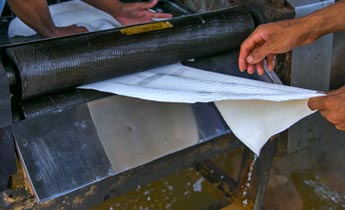Meridian Agro is one of the leading rubber producers in Bangladesh. Natural latex is used by the company to produce dry rubber. Rubber is currently harvested in the form of latex from our 15000 rubber trees. The latex is a muggy, milky colloid drawn off by making incisions into the bark and the fluid is collected in vessels. This process is called "tapping". Machines turn the latex into rubber sheets. This rubber is sold locally, throughout.
Rubber is a versatile product with high potential for growth. We will expand this project to meet the future demand.

Growing and processing natural rubber requires high technical skill and sophisticated machinery.
Seeds from high-grade trees are planted and grown for about 12 to 18 months in the nursery before a new bud is grafted to the seedling. After bud grafting, the year-old seedling tree is cut back and is ready for transplanting. The bud sprouts shortly after transplanting, resulting in a new tree with better properties. Approximately 150 trees are planted per acre (375 per ha), which are cultivated and cared for until they are ready for tapping in about six to seven years.
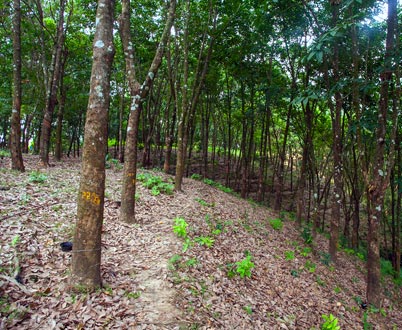
To harvest latex, a worker shaves off a slanted strip of bark halfway around the tree and about one third inch (0.84 cm) deep. Tree must be cut avoiding irreparable damage. However the cut must be deep enough for latex to flow. The latex then bleeds out of the severed vessels, flows down the cut to drops into a collection cup.
Tapping is repeated every other day by making thin shavings just below the previous cut. When the last scar created by the cuts is about 1 ft (0.3 m) above the ground, the other side of the tree is tapped in similar fashion, providing time for the the first side to renews itself. Each tapping takes about three hours and produces less than a cup of latex.
A tapper collects the coagulated latex in the cups. Next, the tapper makes a new cut. The latex first flows rapidly, then declines to a steady rate for a few hours, after which it slows again. By the next day, the flow has nearly stopped as the severed vessel becomes plugged by coagulated latex. To prevent most of the liquid latex from coagulating before it can be conveniently pooled and transported, the tapper adds a preservative such as ammonia or formaldehyde to the collection cup. Both the liquid and coagulated latex is sent to factories for processing.
To increase tree yields and reduce tapping times, chemical stimulants are used. Puncture tapping, in which the bark is quickly pierced with sharp needles, is another method that can improve productivity, since it enables the same worker to tap more trees per day.
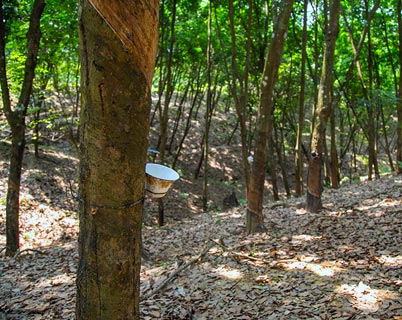
About 10% of the latex is processed into a liquid concentrate by removing some of the water and increasing the rubber content to 60%. This is achieved either by spinning the water out of the latex through centrifugal force, by evaporation, or by a method known as creaming. In this method, a chemical agent is added to the latex that causes the rubber particles to swell and rise to the liquid's surface. The concentrate is shipped in liquid form to factories, where it is used for coatings, adhesives, and other applications.
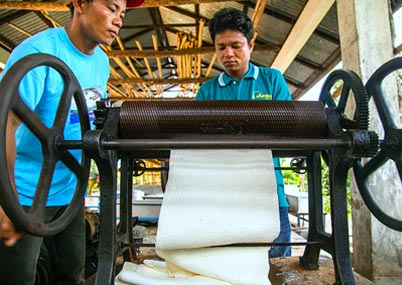
.Other rubber and field latex is coagulated with acid. A giant extrusion dryer that can produce up to 4,000 lbs (1,816 kg) per hour removes the water, creating a crumb-like material. The dried rubber is then compacted into bales and crated for shipment.
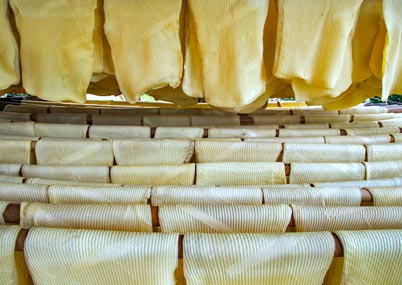
Ribbed smoked sheets are made by first diluting the latex and adding acid. The acid makes rubber particles bunch together above the watery serum in which they are suspended. After several hours, roughly one pound (0.45 kg) of soft, gelatinous rubber coagulates for every three pounds (1.35 kg) of latex.
The rubber is allowed to stand for one to 18 hours, then the slabs are pressed into thin sheets through a system of rollers that wrings out excess liquid. The final set of rollers leaves a ribbed pattern on the sheets that increases the surface area and hastens drying. The sheets are dried for up to a week in smoke houses before being packed and shipped.
After completing rubber sheets, we store the sheets in our storage in a secure way ensuring its better quality for supplying to the markets. We directly supply the rubber from our office to the customers.
